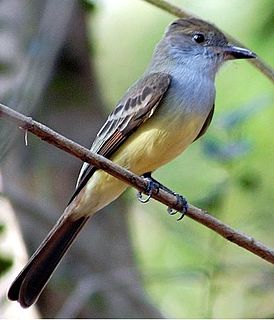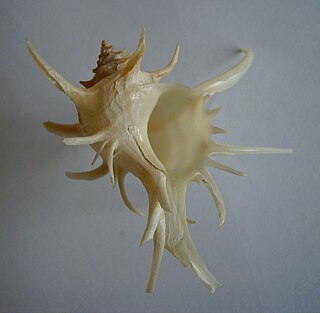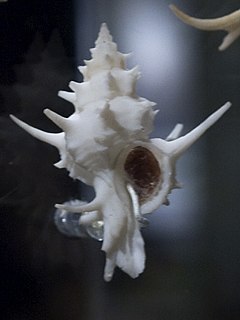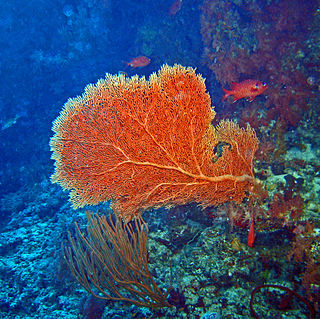
Myiarchus is a genus of tyrant flycatchers. Most species are fairly similar looking and are easier to separate by voice than plumage.

Pallopteridae is a family of flies. The various species are collectively called flutter-wing flies, trembling-wing, or waving-wing flies, because of the striking vibration of the wings in many species. Over 70 species in about 15 genera are found in the temperate regions of the Northern and Southern Hemispheres.

Nutting's flycatcher, Myiarchus nuttingi, is a passerine bird in the tyrant flycatcher family. It breeds in semi-arid desert scrub and tropical deciduous forest from western Mexico to northwest Costa Rica. It is normally a year-round resident, but has been known as an occasional vagrant to southern California and Arizona–(southeastern, central, and western), in the United States. It is named for the zoologist Charles Cleveland Nutting.

Poirieria is a genus of large predatory sea snails, marine gastropod molluscs in the family Muricidae, the rock snails.

The Encyclopedia of Life (EOL) is a free, online collaborative encyclopedia intended to document all of the 1.9 million living species known to science. It is compiled from existing databases and from contributions by experts and non-experts throughout the world. It aims to build one "infinitely expandable" page for each species, including video, sound, images, graphics, as well as text. In addition, the Encyclopedia incorporates content from the Biodiversity Heritage Library, which digitizes millions of pages of printed literature from the world's major natural history libraries. The project was initially backed by a US$50 million funding commitment, led by the MacArthur Foundation and the Sloan Foundation, who provided US$20 million and US$5 million, respectively. The additional US$25 million came from five cornerstone institutions—the Field Museum, Harvard University, the Marine Biological Laboratory, the Missouri Botanical Garden, and the Smithsonian Institution. The project was initially led by Jim Edwards and the development team by David Patterson. Today, participating institutions and individual donors continue to support EOL through financial contributions.
The Nicaraguan seed finch is a species of bird in the family Thraupidae. It is found in Costa Rica, Nicaragua and northwestern Panama.

Charles Cleveland Nutting was an American zoologist, born in Jacksonville, Illinois. He graduated from Blackburn University (1880) and received the M. A. degree from the same institution in 1882. He conducted various zoological expeditions—in Central America for the Smithsonian Institution (1882–84), in Florida (1885), on the Saskatchewan River (1891)—and was naturalist of the Albatross Hawaiian expedition in 1902. He was professor of zoology and curator of the Museum of Natural History of the University of Iowa from 1886 to 1890 and thereafter was head of his department. Nutting's most important publications are systematic papers dealing with marine hydroids, which appeared in the reports of the United States Commission of Fisheries and elsewhere and were reprinted, especially American Hydroids. In this work Nutting described 124 new species and beautifully illustrated his monograph on American hydroids.
Paracerceis is a genus of isopod crustacean in the family Sphaeromatidae. It contains the following species:

Cerylonidae are small to tiny, smooth, shiny, hairless beetles, only lightly punctured. There are about 450 species worldwide in 50 or so genera, mostly tropical and subtropical. They are most common under the bark of dead trees, but can also occur in compost and other decaying plant material. Little is known specifically about their biology but they are thought to be either predators that feed on other small animals or fungus eating.
Paziella nuttingi, common name : Nutting's Murex, is a species of sea snail, a marine gastropod mollusk in the family Muricidae, the murex snails or rock snails.

Paziella is a genus of sea snails, marine gastropod mollusks in the family Muricidae, the murex snails or rock snails.

Subergorgia is a genus of soft corals belonging to the family Subergorgiidae.

iNaturalist is a citizen science project and online social network of naturalists, citizen scientists, and biologists built on the concept of mapping and sharing observations of biodiversity across the globe. iNaturalist may be accessed via its website or from its mobile applications. Observations recorded with iNaturalist provide valuable open data to scientific research projects, conservation agencies, other organizations, and the public. The project has been called "a standard-bearer for natural history mobile applications."

Polyipnus nuttingi, commonly known as the Nutting's hatchet fish, is a species of ray-finned fish in the family Sternoptychidae. It occurs in deep water in the Indo-Pacific Ocean, at depths between about 384 and 658 metres.
Paraidemona olsoni is a species of spur-throated grasshopper in the family Acrididae. It is found in North America.
Paraidemona is a genus of spur-throated grasshoppers in the family Acrididae. There are about nine described species in Paraidemona.
Paraidemona punctata is a species of spur-throated grasshopper in the family Acrididae. It is found in North America.
Paraidemona latifurcula is a species of spur-throated grasshopper in the family Acrididae. It is found in North America.
Paraidemona mimica, the mimic grasshopper, is a species of spur-throated grasshopper in the family Acrididae. It is found in North America.












